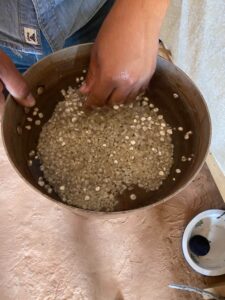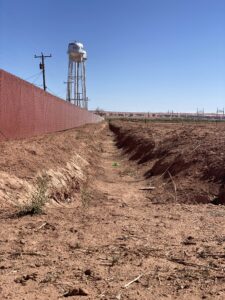By Shantel Chee
Jenny Harvey sits with a shoebox next to her. She opens the shoebox to reveal blue, red, white, and mixed corn. She reaches down and grabs the smallest corncobs. “These are the corn that doesn’t get enough water,” she says. The cobs are about 5 inches long with hardly any corn kernels attached.
Harvey (Diné), 70, the former Rock Point Chapter president, grew up in the community and taught culture and traditional class at the local community school before she retired. She also worked with her father in the fields planting corn. She opens another container. “These corn I planted a long time ago, when we had water,” she says as she hands over two large white cobs.
Harvey has multiple photos from 2007 of fields full of water and corn that had been treated correctly, but lately, she says, “Fields are not getting enough of the nutrients they need.”
Corn relies so much on water that the seed can sprout only if it receives multiple gallons. Harvey says that the dam in Rock Point gets its water from the Lukachukai mountains, which provide the best water for planting. This year it snowed about 4 inches in the mountains and the community knows water will arrive soon, but because of climate change, that water may not flow all the way to Rock Point—instead drying up in the desert sand. Community members in Rock Point, Arizona, have been dealing with water issues for a long time, and it affects many fields that grow fresh vegetables and fruits.
Tyrell Descheny (Diné), 27, an influencer and weaver, spins his wool with a rhythm. Bright patterned Pendleton blankets line his hogan’s walls. His two rug looms hold his designs, and the yarn he has cut, untangled and spun, hangs from his unfinished creations. Descheny grabs a large light turquoise pot underneath a shelf and shows what is inside: white corn kernels soaking in cold water. “I let these corn sit in the water for a few days before I started planting,” Descheny says.

When it’s time to head to the field, he hops in the truck and stops at a shed house near his parents’ house to retrieve shovels and other equipment. The truck takes some good bumps as he passes lines of barbed-wire fences. Very little is green in the area due to livestock that eat whatever they can.
Descheny places the turquoise pot next to the hole the seeds will be planted in. “I usually don’t plant the corn or any other plant in the same spot from the previous year, just so the sand can reenergize for more moisture and won’t damage it.”
Descheny removes as much sand as he can and works from the south side of the field toward the north. “I would put three to four seeds together, then add water before covering it with sand.” After adding seeds to the ground, then covering and watering them, Descheny grabs the shovel again and places the sand around the corn. “A perfect hill circle is what you want so the water can stay inside and keep the corn wet to grow strong,” he says. Patience is the key to this whole process. The hard work will soon pay off, as the field will provide a delicious crop to eat in the end.
Up the road, Florian Johnson (Diné), 53, says he started planting at the age of 5. He grew up in the Rock Point community and works as a K-12 culture specialist at the Rock Point community school. Growing up, Johnson removed many weeds and assisted his parents and grandparents in the fields when he was home.

Johnson didn’t plan to continue maintaining his family fields when he was an adult until he began to miss the traditional food he had learned how to harvest from his grandparents’ fields. “I like the food. You go off the reservation and the way you were raised on the reservation with a different type of food, you don’t even think about it,” Johnson says. “You began to miss those types of things as food and so forth.”
So Johnson started to plant. But over the years, like many community members, Johnson downsized his gardens due to a lack of water. He tries his best to use drip-line irrigation water if he is planting his fields or tap water from the sink for his garden, but between a lack of water and roaming animals, it’s hard.
Descheny’s, Harvey’s, and Johnson’s styles of planting don’t differ much, but the results vary, depending on the water source they use for their plants. The three planters either haul water or run a hose from their homes to make their plants grow large and ready to eat before fall arrives. Caring for their plants involves weekly visits to the fields, decreasing the weeds, nonstop dedication, and teamwork, but they say it’s worth the effort.

Shantel Chee is Diné and attends the Institute of American Indian Arts where she is double majoring in creative writing and studio arts. Her vision for her work is to share unique stories through the journey she is walking. Shantel is a one of a kind person to meet one day, enjoy her work.